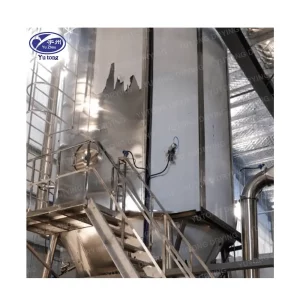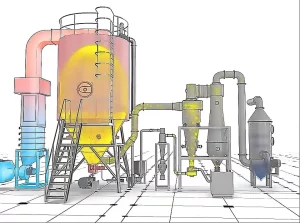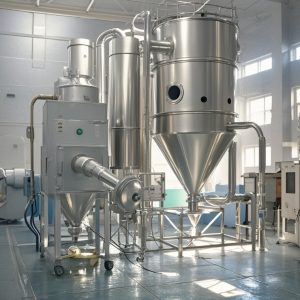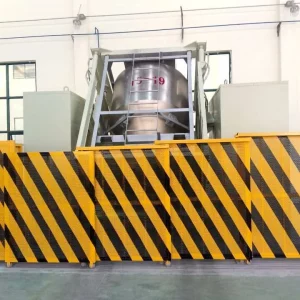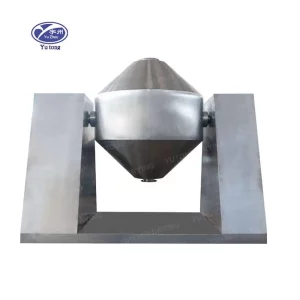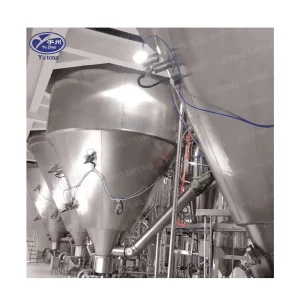how to calculate spray dryer capacity
Spray dryers are essential in various industries, from food processing to pharmaceuticals, where they transform liquid substances into dry powders. Understanding how to calculate a spray dryer’s capacity is crucial for optimizing its efficiency and ensuring that it meets production needs. In this article, we’ll walk you through the key concepts and calculations involved in determining spray dryer capacity, alongside some practical tips for improving spray dryer efficiency.
Understanding Spray Dryer Basics
Before we dive into the calculations, it’s essential to understand the essential operation of a spray dryer. A spray dryer works by atomizing a liquid feed into a hot drying medium, typically air. The liquid droplets quickly evaporate, leaving behind a fine powder. The primary components of a spray dryer include:
Atomization Process
The atomizer is a critical component that disperses the liquid into fine droplets. Atomization can be achieved through various methods such as rotary, nozzle, or pressure systems, each offering distinct advantages depending on the application. Understanding the differences in atomization methods can help in selecting the right equipment for specific product requirements. Fine droplets ensure a larger surface area for efficient drying, significantly impacting the drying rate and final product quality.
Drying Chamber Dynamics
The drying chamber is where the magic happens, as the moisture is evaporated from the atomized droplets. The design and size of the drying chamber play a significant role in determining the residence time of particles and the efficiency of the drying process. Factors such as chamber shape, air distribution, and insulation contribute to optimizing the drying conditions. Properly designed drying chambers ensure uniform drying and prevent issues like product sticking or uneven particle size distribution.
Cyclone Separator and Bag Filter Functionality
The cyclone separator or bag filter is vital for separating the dried powder from the exhaust air. Cyclone separators use centrifugal forces to remove particles, while bag filters utilize filtration media. Understanding the operational principles and maintenance requirements of these components can enhance powder recovery and minimize product loss. Efficient separation systems contribute to cleaner exhaust emissions and improved environmental compliance.
Heating Systems and Heat Transfer
The heating system provides the necessary thermal energy for the drying process. Different heating sources, such as gas, steam, or electricity, can be utilized based on energy availability and cost considerations. Efficient heat transfer mechanisms ensure that the maximum amount of energy is transferred to the drying air, thereby optimizing the drying process. Properly designed heating systems contribute to energy savings and reduce operational costs.
Exhaust and Ventilation Systems
Managing exhaust and ventilation is crucial for maintaining safe and efficient spray dryer operations. Exhaust systems remove moisture-laden air, while ventilation ensures proper airflow and temperature control. Implementing effective exhaust and ventilation strategies prevents overheating, reduces fire risks, and maintains product quality. Regular monitoring and maintenance of these systems are essential for continuous and reliable spray drying operations.
Key Design Parameters
Several design parameters influence the capacity of a spray dryer:
Inlet and Outlet Temperature Management
Inlet temperature is the temperature of the hot air entering the dryer, which directly affects the drying rate. Higher inlet temperatures can increase drying efficiency but may also risk product degradation. Conversely, the outlet temperature is crucial for determining the completeness of drying. Balancing these temperatures ensures optimal drying conditions without compromising product integrity.
Air Flow Rate Optimization
The drying air flow rate is the volume of air passing through the dryer. It influences the heat and mass transfer rates, impacting the overall drying efficiency. Adjusting air flow rates can optimize energy consumption and improve drying performance. Variable speed fans and advanced control systems can aid in achieving the ideal airflow for different drying scenarios.
Liquid Feed Rate Control
The liquid feed rate is the amount of liquid being fed into the dryer. It needs to be precisely controlled to ensure consistent drying and product quality. Variations in feed rate can lead to uneven drying, affecting the final product’s characteristics. Implementing flow control devices and monitoring systems helps maintain a steady feed rate for optimal results.
Atomization Pressure Adjustments
Atomization pressure is the pressure at which the liquid is atomized into droplets. It plays a critical role in determining droplet size and distribution, impacting drying efficiency. Adjusting atomization pressure can help achieve the desired particle size and improve drying uniformity. Understanding the relationship between pressure, droplet size, and drying rate is essential for effective spray-drying operations.
Humidity and Moisture Control
Controlling humidity and moisture levels in the drying air is crucial for achieving the desired product moisture content. High humidity can reduce drying efficiency, while low humidity can lead to over-drying. Implementing humidity control systems and monitoring devices ensures consistent drying conditions and product quality. Proper humidity management is key to achieving optimal spray dryer performance.
Calculating Spray Dryer Capacity
To calculate the capacity of a spray dryer, you need to determine the drying rate and the amount of moisture to be removed. Here’s a step-by-step guide:
Step 1: Determine the Moisture Content
Find the initial moisture content in the liquid feed and the desired moisture content in the final product. This information is crucial for calculating the amount of water that needs to be evaporated.
- Initial Moisture Content (IMC): The percentage of water in the liquid feed. Understanding the water content helps in estimating the total moisture load on the dryer. Various methods, like moisture analyzers or laboratory tests, can be used to determine the IMC accurately.
- Final Moisture Content (FMC): The percentage of water desired in the final product. This is critical for ensuring the product meets quality specifications and storage requirements. Adjusting the FMC can affect product characteristics like shelf life and flowability.
Step 2: Calculate the Amount of Water to Evaporate
Use the following formula to find the amount of water that needs to be evaporated per hour:
[ \text{Water to Evaporate (kg/hr)} = \frac{\text{Liquid Feed Rate (kg/hr)} \times (\text{IMC} – \text{FMC})}{100} ]
This calculation gives the total mass of water to be removed, serving as a basis for further capacity calculations. Accurately estimating the water to evaporate is vital for sizing the spray dryer and associated systems.
Step 3: Calculate the Drying Rate
The difference between the inlet and outlet air temperatures and the air flow rate determines the drying rate. Use the formula:
[ \text{Drying Rate (kg/hr)} = \text{Air Flow Rate (m}^3\text{/hr)} \times \text{(Inlet Temp – Outlet Temp)} ]
This calculation estimates the energy available for drying, helping to assess the dryer’s efficiency. Understanding the drying rate enables operators to optimize conditions for maximum throughput and energy utilization.
Step 4: Calculate the Spray Dryer Capacity
Finally, you can determine the spray dryer capacity using the drying rate and the amount of water to evaporate:
[ \text{Spray Dryer Capacity (kg/hr)} = \frac{\text{Water to Evaporate (kg/hr)}}{\text{Drying Rate (kg/hr)}} ]
This formula gives the spray dryer’s theoretical capacity, allowing adjustments in design or operation to achieve desired production levels. Knowing the capacity helps in planning and scaling spray drying operations efficiently.
Improving Spray Dryer Efficiency
Enhancing the efficiency of a spray dryer can lead to significant cost savings and improved product quality. Here are some strategies to consider:
Optimize Inlet and Outlet Temperatures
Ensure that the inlet temperature is high enough to maximize drying efficiency without degrading the product. Similarly, maintain an optimal outlet temperature to ensure complete drying. Regularly reviewing and adjusting temperature settings based on product requirements can enhance efficiency.
Adjust Air Flow Rate
Properly balancing the air flow rate can improve heat transfer and reduce energy consumption. Consider using variable-speed fans to adjust the airflow as needed. Implementing advanced control systems can facilitate dynamic adjustments for varying production demands.
Enhance Atomization
Using advanced atomization technologies can produce finer droplets, leading to faster and more uniform drying. Researching and investing in cutting-edge atomization equipment can improve product quality and process efficiency. Regular maintenance of atomizers ensures consistent performance and minimizes downtime.
Implement Real-Time Monitoring
Invest in sensors and control systems to monitor critical parameters like temperature, humidity, and airflow in real time. This allows for quick adjustments and ensures consistent product quality. Real-time data analytics can provide insights for continuous process improvement and troubleshooting.
Regular Maintenance
Perform regular maintenance on the spray dryer to prevent any blockages or mechanical issues that could hinder performance. Scheduled inspections and cleaning can extend equipment lifespan and maintain operational efficiency. Developing a comprehensive maintenance plan can minimize unexpected failures and production disruptions.
Energy Efficiency Measures
Implement energy-saving measures such as heat recovery systems and insulation improvements to reduce operational costs. Conducting energy audits can identify areas for improvement and potential savings. Investing in energy-efficient components and technologies contributes to sustainable spray drying operations.
Practical Applications and Considerations
Spray Dryer Design for Milk Powder
Spray drying is commonly used in the dairy industry to produce milk powder. When designing a spray dryer for milk powder, consider factors like the thermal sensitivity of milk proteins and the need for consistent particle size. Understanding the specific requirements of dairy products can help in selecting appropriate design features and operational parameters.
Calculating Adiabatic Saturation Temperature
Calculating the adiabatic saturation temperature, which represents the point at which air is saturated with moisture, is essential for optimizing drying efficiency in spray dryer applications. Accurate calculations can inform adjustments to drying conditions, enhancing energy efficiency and product quality.
Process Flow Diagram
A process flow diagram of a spray dryer can help visualize the entire drying process, from liquid feed to powder collection, and identify potential areas for improvement. Creating detailed diagrams aids in troubleshooting and process optimization. Collaboration between engineering and operations teams can enhance the accuracy and utility of process flow diagrams.
Spray Dryer Project Report
When planning a spray dryer project, a comprehensive report detailing the design considerations, capacity calculations, and expected efficiency improvements is invaluable for stakeholders. Including detailed analysis and projections can facilitate informed decision-making and secure project approval. Regular updates to the project report ensure transparency and continuous alignment with project goals.
Environmental and Safety Considerations
Addressing environmental and safety concerns is critical in spray dryer operations. Implementing emission control systems and safety protocols can mitigate risks and ensure regulatory compliance. Regular training and audits promote a culture of safety and environmental responsibility within the organization.
Conclusion
Calculating a spray dryer’s capacity is a complex but essential task for ensuring efficient operation and meeting production requirements. By understanding the key parameters and implementing strategies to enhance efficiency, you can optimize your spray drying process and achieve superior results. Whether you’re working on a large-scale industrial application or a smaller project, these insights will help you make informed decisions and improve your spray drying operations. Continuous innovation and adherence to best practices will drive success and sustainability in spray drying endeavors.

